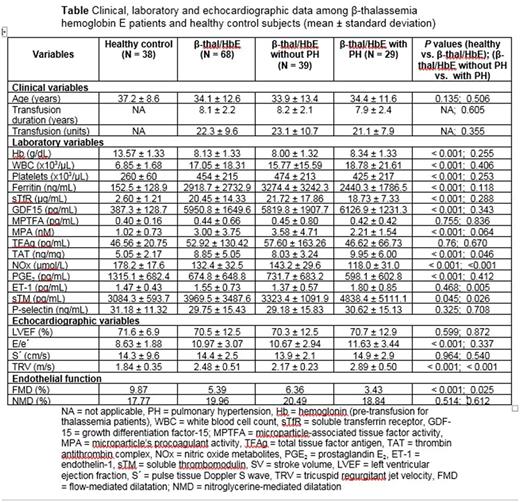Abstract
Background: β-thalassemia hemoglobin E (β-thal/HbE) is currently the commonest β-thalassemia disease worldwide. Pulmonary hypertension (PH) is the most common cardiovascular complication in this genotype, especially in splenectomized patients. Yet the pathogenesis of this major complication remains poorly characterized. Most of the previous reports investigated pathophysiology of PH in β-thal/HbE with inadequate transfusion. In this study we aimed to define the prevalence and comprehensively explore mechanisms of PH in β-thal/HbE patients receiving regular transfusion and iron chelation which were reported to alleviate PH. Our findings will provide deeper insights into pathogenesis and identify targets for management of persistent PH in thalassemia patients after adequate transfusion and chelation.
Methods: β-thal/HbE patients who received regular transfusion ≥ 1 unit per month and any forms of iron chelation over 1 year were eligible for the study. Normal healthy subjects were used as controls. Blood sample collection and echocardiographic assessment were performed on the same days. Patients at risk for PH were defined by the tricuspid regurgitant jet velocity (TRV) ≥ 2.5 m/s.
Results: There were 68 β-thal/HbE and 38 healthy controls enrolled between May and September 2015. The ages (mean ± SD) were 34.1 ± 12.6, ranging from 19-67 years, and 37.2 ± 8.6 years, ranging from 18-70 years, respectively. Among 68 β-thal/HbE, the average transfusion duration was 8.1 ± 2.2, ranging from 2.2-10.6 years, and the quantity of transfusion was 22.3 ± 9.6 units per year. The pre-transfusion hemoglobin (Hb) level was 8.1 ± 1.3 g/dL. There were 31 (45.6%) splenectomized patients. β-thal/HbE showed markedly increased erythropoiesis (growth differentiation factor, GDF15, and soluble transferrin receptor, sTfR, levels) and iron load (serum ferritin) compared to controls, all p < 0.001. Thrombin antithrombin (TAT) complex and microparticle's procoagulant activity (MPA) were significantly elevated (both p < 0.001), but total tissue factor antigen (TFAg) and microparticle-associated tissue factor activity (MPTFA) were not different from those of controls, suggesting TF-independent hypercoagulability. Serum nitric oxide metabolites (NOx) and prostaglandin E2 (PGE2) levels were significantly lower than those of controls (both p < 0.001), while soluble thrombomodulin (sTM) levels were significantly elevated (p= 0.045). Serum endothelin-1 (ET-1) and soluble p-selectin levels were not different between patients and controls. Echocardiographic profiles demonstrated preserved biventricular systolic functions in β-thal/HbE with a significant increase in TRV (p < 0.001).
Among β-thal/HbE, there were 29 (42.6%; 16 non-splenectomized and 13 splenectomized) cases at risk for PH. Duration and amount of transfusion, pre-transfusion Hb, GDF15 and sTfR levels were not statistically different between PH and non-PH subgroups indicating the similar degree of erythropoiesis. Notably, β-thal/HbE with PH had a significant reduction in NOx levels (p < 0.001) but elevations in TAT, ET-1 and sTM levels compared to those without PH (p= 0.046, 0.005 and 0.026, respectively). Additionally, TRV was significantly correlated with NOx, TAT, sTM and ET-1 levels (r = -0.514, p < 0.001; r = 0.281, p= 0.004; r = 0.313, p= 0.001; and r = 0.245, p= 0.012, respectively). Serum ferritin, MPA, MPTFA, TFAg and PGE2 levels were not statistically different between PH and non-PH subgroups. Surprisingly, there were no differences in any biomarkers and echocardiographic profiles between splenectomized and non-splenectomized patients as well as no significant associations between splenectomy statuses and PH (Χ2 = 0.012, p= 0.914).
We reviewed another β-thal/HbE cohort with available flow mediated dilatation (FMD) data. 9 β-thal/HbE with PH had significantly lower FMD (3.43%) compared to 18 β-thal/HbE without PH (6.37%) and 27 age-sex matched controls (9.87%; p= 0.025 and p < 0.001, respectively) indicating a greater degree of endothelial dysfunction in β-thal/HbE having PH. In addition, TRV was significantly correlated with FMD (r = -0.474, p < 0.001).
Conclusions: PH is still prevalent in β-thal/HbE patients receiving long-term regular transfusion and iron chelation. In this group, PH is not associated with splenectomy statuses but correlated with NO depletion, TF-independent hypercoagulation and endothelial dysfunction.
Sutcharitchan: Chulalongkorn University: Consultancy, Employment; Celgene: Research Funding.
Author notes
Asterisk with author names denotes non-ASH members.


This feature is available to Subscribers Only
Sign In or Create an Account Close Modal